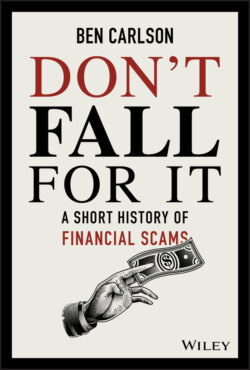Читать книгу Don't Fall For It - Carlson Ben, Ben Carlson - Страница 14
CHAPTER 2 How to Sell Anything
ОглавлениеThere are some frauds so well conducted that it would be stupidity not to be deceived by them.
—Charles Cotton
The Eiffel Tower is one of the most recognizable and well-trafficked monuments in the world. Each year, it’s estimated well over six million visitors wait in long lines to experience this gorgeous landmark. It may be hard to believe, but when it was built the tower was subject to ridicule and was only supposed to stand for 20 years before being disassembled.
Gustave Eiffel designed his namesake tower for the 1889 World’s Fair in Paris. No one had ever built a structure so tall before so the fact that it was erected in just over two years is a technical feat that was unparalleled at the time. Naysayers told Eiffel the tower would be impossible to build. The wind would make it too dangerous for people to ascend to such heights and the government wasn’t keen on spending an estimated $1 million on the project. His contract stipulated that the tower would be allowed to stand for 20 years to be able to earn enough of a profit to make it worthwhile, at which point the erector set–looking structure would be taken down piece by piece.
The engineering and construction involved required an incredible amount of precision. The iron plates used to build the tower would have stretched 43 miles long if they were laid end-to-end and called for over seven million holes to be drilled into them. The iron used to construct the tower weighed over 7,000 tons and required more than 60 tons of paint. Each piece was traced out to be accurate within a tenth of a millimeter. There were 2.5 million rivets used in construction. Including the flagpole at the top, the Eiffel Tower reached 1,000 feet in height when it was finished.[1]
Although the tower was more beautiful than most could have imagined, it was initially panned by critics. Many of France’s leading artists and intellectuals derided the tower, calling it “a truly tragic street lamp” and an “iron gymnasium apparatus, incomplete, confused, and deformed.” The Americans and Brits weren’t fans either, mostly because they were jealous. The New York Times called it “an abomination and eyesore.” Editors at the London Times referred to it as the “monstrous erection in the middle of the noble public buildings of Paris.” Americans didn’t appreciate how the Eiffel Tower surpassed the Washington Monument as the tallest man-made structure at that time. Once it was completed even the most ardent critics eventually came around to the fact that it was a masterpiece, yet the government still wasn’t positive they would keep the structure in place forever. In the years after the tower was built it began to fall into disrepair. It was costing the city a fortune in maintenance and upkeep.[2]
A man by the name of Victor Lustig saw this situation as an opportunity to profit from the uncertainty surrounding the future of this magnificent monument. Lustig decided he would sell the Eiffel Tower to the highest bidder … twice.
